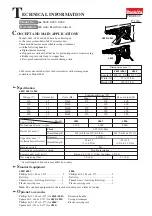
SL SERIES MANUAL
8
118006-001 REV T
J)
Depress and hold the HIGH VOLTAGE OFF switch.
The front panel meters will now read the preset value
of the KILOVOLT control dial and the
MILLIAMPERES control dial. To preset the desired
level of current and voltage during operation, hold in
the HIGH VOLTAGE OFF switch and rotate the
appropriate control dial while noting its
corresponding meter reading. Release the HIGH
VOLTAGE OFF switch.
NOTE:
No actual output is being produced at this stage.
K)
Depress the HIGH VOLTAGE ON switch. The light
inside the switch should light up and the output will
slow start to the preset level output voltage and/or
output current.
NOTE:
The SL Series is equipped with a slow start
circuit that ramps the output up to its maximum
setting in approximately 6 seconds after the HIGH
VOLTAGE ON switch is depressed.
L)
To terminate the generation of output power, depress
the HIGH VOLTAGE OFF switch. In the HIGH
VOLTAGE OFF mode the power supply’s fault and
interface circuits are still active.
M)
To turn off the power supply, turn the circuit breaker
to the off position (0).
NOTE:
If a power supply fault, or system
monitoring fault occurs, the power supply will revert
to the POWER DOWN mode. In this mode the
output power will be turned off. The HV OFF lamp
will be off. To reset, depress the HV OFF switch.
AFTER TURNOFF, DO NOT HANDLE THE LOAD
UNTIL THE CAPACITANCE HAS BEEN
DISCHARGED!
LOAD CAPACITANCE MAY BE DISCHARGED BY
SHORTING TO GROUND.
THE VOLTMETER ON THE POWER SUPPLY
FRONT PANEL DOES NOT READ THE OUTPUT
VOLTAGE WHEN THE POWER IS TURNED OFF,
EVEN IF A CHARGE STILL
EXISTS ON THE LOAD.
CAUTION
ALWAYS OPERATE THE UNIT WITH THE COVER
ON.
A fan maintains safe operating temperature in 600W-
1200W power supplies by drawing air over the circuit
components. The cover must be on in order to direct the
air flow over the areas that need cooling. In operation,
the unit must be placed so that the air intake and the fan
exhaust are clear of obstructions that might impede the
flow of air. The 10W-300W units do not use forced air
cooling. Simply maintain ambient temperature
specifications.
3.2 Standard Features
A note on remote interface circuitry and remote signal
grounding. Whenever possible, electrical isolation should
be provided when interfacing with any high voltage
power supply. For power control signals such as
EXTERNAL INTERLOCK, HIGH VOLTAGE OFF,
AND HIGH VOLTAGE ON, isolated relay contacts
should be used. For status signals and control signals
such as HIGH VOLTAGE ON, HIGH VOLTAGE OFF,
and EXTERNAL INHIBIT, etc., opto-isolation should be
used. If possible, analog programming and monitoring
signals should be isolated via analog isolation amplifiers.
Spellman application engineers are available to assist in
interface circuitry design. All interface cables should be
properly shielded. All power supply signals should be
referenced to the power supplies signal ground on the rea
external interface.
•
REMOTE PROGRAMMING:
Allows remote
adjustment of the output voltage and current via an
external voltage source. (Output power is also
remotely controllable with the CPC and APT
options). In local control (front panel control),
jumpers are installed on the external interface TB1
(or J5) in the rear of the chassis between TB-10 (J5-
10) and TB1-11 (J5-11) for voltage control and
between TB1-8 (J5-8) and TB1-9 (J5-9) for current
control.
WARNING
For remote programming, the jumpers are removed and a
positive voltage source, from 0V to 10V, is applied to the
appropriate terminals. Programming signals should be
referenced to TB1-1 (J5-1), signal ground. By adjusting
the voltage source from 0V (zero output) to 10V (full
rated output), the desired output can be selected. See
Figure 3.2A on page 13 for the wiring diagram and
specifications.
WARNING
An alternate method of controlling the output remotely is
by using external resistance, such as a potentiometer or a
















































